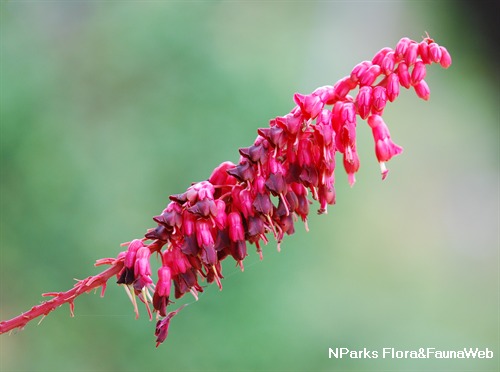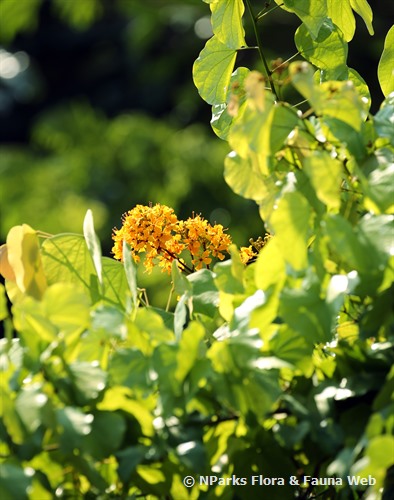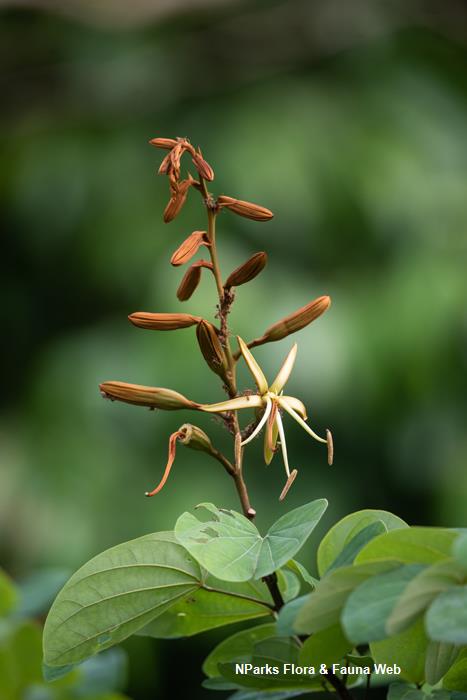
Back
Phanera semibifida (Roxb.) Benth. var. semibifida
| Family Name: | Fabaceae (Leguminosae) |
| Synonyms: | Bauhinia semibifida Roxb. var. semibifida |
| Common Name: | Common Bauhinia |
Name
Classifications and Characteristics
| Plant Division | Angiosperms (Flowering Seed Plants) (Dicotyledon) |
|---|---|
| Plant Growth Form | Climber |
| Lifespan (in Singapore) | Perennial |
| Mode of Nutrition | Autotrophic |
Biogeography
| Native Distribution | Sumatra, Peninsular Malaysia, Singapore, the Philippines, Borneo, and Sulawesi |
|---|---|
| Native Habitat | Terrestrial (Primary Rainforest, Secondary Rainforest, Freshwater Swamp Forest, Disturbed Area / Open Ground) |
| Preferred Climate Zone | Tropical |
| Local Conservation Status | Native to Singapore (Least Concern (LC)) |
Description and Ethnobotany
| Growth Form | It is a woody climber that consists of a stem up to 15 cm wide. Its stem is covered with brown hairs that are lost through abrasion as the plant ages. |
|---|---|
| Foliage | Its simple, stalked leaves possess bilobed leaf blades that resemble the wings of a butterfly flattened out, are 4–11 cm wide, and covered with brown hair below. |
| Flowers | Its flowering shoot develops from the tips of branches or leaf axils. It consists of stalked flowers that are bilaterally symmetrical, with five white petals that will turn yellow with age. |
| Fruit | Its fruits are like dried, woody, strap-straped, bean pods that are 10–20 by 3–4 cm. Each fruit bears up to 6 disc-like, flat seeds within. |
| Habitat | It grows along open areas in forests, and forest edges up to 2000 m altitude. |
| Cultivation | It can be propagated by seed or air layering. |
| Etymology | Latin Bauhinia, commemorating Johann (Jean) and Caspar (Gaspard) Bauhin, two Swiss brothers and botanists; Latin semi, half; Latin bifida, cleft into two parts, referring to the half cleft leaf blades of this species |
| Ethnobotanical Uses | Medicinal: Its powdered roots are used medicinally in Malay folk medicine. |
Landscaping Features
| Landscaping | The plant is cultivated for its attractive foliage and flowers. It may be suitable for vertical greening and for planting in parks and gardens. |
|---|---|
| Desirable Plant Features | Ornamental Flowers, Ornamental Foliage |
| Landscape Uses | Parks & Gardens, Vertical Greenery / Green Wall, Trellis / Arbour / Pergola |
Fauna, Pollination and Dispersal
| Pollination Method(s) | Biotic (Fauna) |
|---|---|
| Seed or Spore Dispersal | Biotic (Fauna), Abiotic |
Plant Care and Propagation
| Light Preference | Full Sun, Semi-Shade |
|---|---|
| Water Preference | Moderate Water |
| Plant Growth Rate | Fast |
| Rootzone Tolerance | Moist Soils, Well-Drained Soils, Fertile Loamy Soils |
| Propagation Method | Seed, Air-Layering |
Foliar
| Foliage Retention | Evergreen |
|---|---|
| Mature Foliage Colour(s) | Green, Green - Light Green |
| Mature Foliage Texture(s) | Smooth |
| Foliar Type | Simple / Unifoliate |
| Foliar Arrangement Along Stem | Alternate |
| Foliar Attachment to Stem | Petiolate |
| Foliar Shape(s) | Non-Palm Foliage |
| Foliar Venation | Pinnate / Net |
| Foliar Margin | Entire |
Floral (Angiosperm)
| Flower & Plant Sexuality | Bisexual Flowers |
| Flower Colour(s) | White, Yellow / Golden, Cream / Off-White |
|---|---|
| Flower Grouping | Cluster / Inflorescence |
| Flower Location | Axillary, Terminal |
| Flower Symmetry | Bilateral |
Fruit, Seed and Spore
| Mature Fruit Colour(s) | Brown |
|---|---|
| Fruit Classification | Simple Fruit |
| Fruit Type | Dehiscent Dry Fruit , Legume / Pod |
Image Repository
Others
| Master ID | 30 |
|---|---|
| Species ID | 1326 |
| Flora Disclaimer | The information in this website has been compiled from reliable sources, such as reference works on medicinal plants. It is not a substitute for medical advice or treatment and NParks does not purport to provide any medical advice. Readers should always consult his/her physician before using or consuming a plant for medicinal purposes. |











